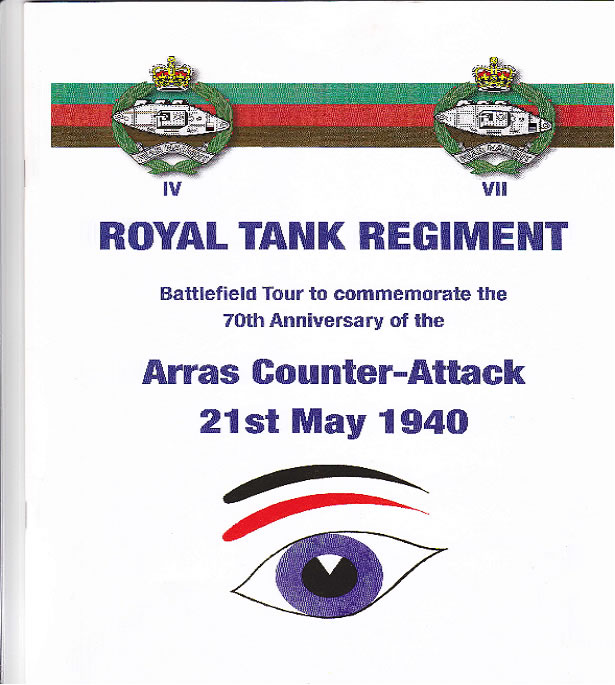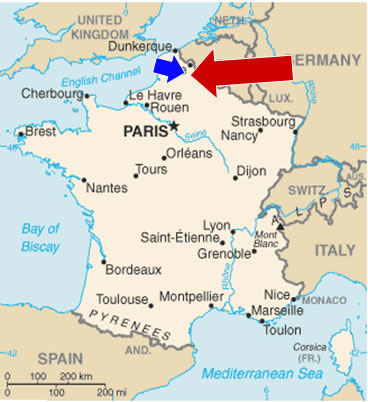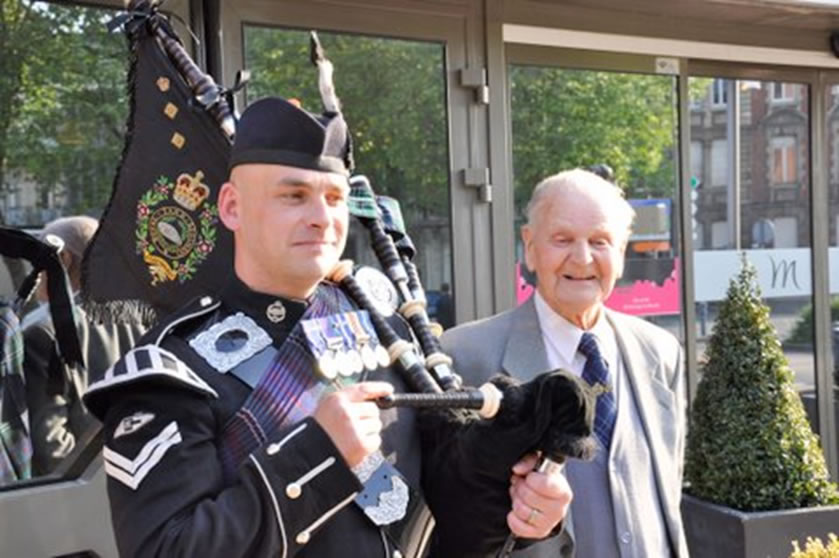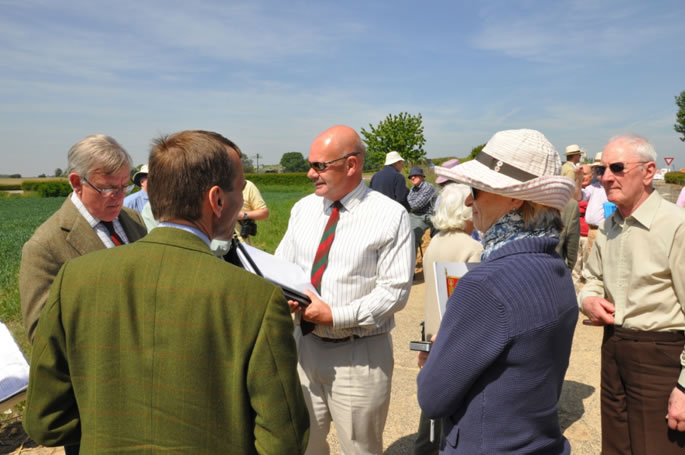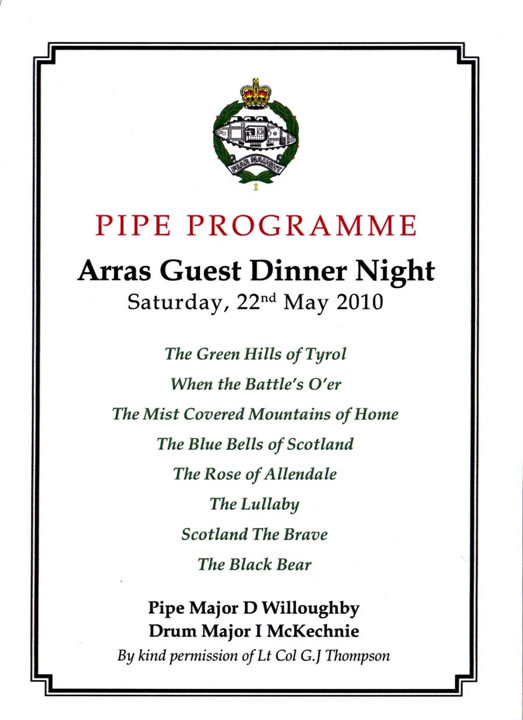2010 – The Last Hurrah
An annual Reunion of those who served in the Fourth and Seventh Royal Tank Regiments was held without a break from 1973 to 2009. We decided, however that our Reunion in 2010 would be our last, and that it would be held in Arras astride the 21st of May. Just seventy years ago to the day both Regiments had fought there to halt the advance of the German Army Group A’s hitherto unstoppable blitzkrieg towards the Channel coast. Their success made Dunkirk possible.
A strong committee under the direction of Brigadier Nick Cocking facilitated one hundred and forty six of us assembling at Arras on Friday 21 May 2010, occupying many of the hotels in the City. The party consisted of ninety six past members of the Fourth and Seventh, together with the Commanding Officer, Lt Col Gavin Thompson, and fifty serving officers, warrant officers, sergeants and men from 1 RTR, into which by amalgamation the Fourth and Seventh’s history and traditions had been absorbed.
Arras has been fought over ever since 1668 when Vauban made it one of his Frontier fortresses. More recently it has been the scene of furious fighting in 1914 and in the brutal battle of Vimy Ridge in 1917. Then in mid-May 1940 it was the scene of the vicious confrontation which we had assembled in Arras to commemorate.
There can be no doubt that the Arras counter attack was a highly significant event. As we shall see it had a direct effect upon the German Commander-in-Chief, Colonel General Von Rundstedt and, in turn, upon Hitler himself who on 24 May called a three day halt to any further advance of the German leading elements. That halt made possible the evacuation of 335,000 allied troops across the beaches of Dunkirk. We see this reflected in Von Rundstedt’s diary and in the writings of the premier British military historian, Liddell Hart.
Field Marshal von Rundstedt, Commander in Chief of the Army Group wrote of the counter – attack in his diary..
“A critical moment in the drive came just as my forces had reached the Channel. It was caused by a British counter-stroke southwards from Arras on May 21. For a short time it was feared that the panzer divisions would be cut off before the infantry divisions could come up to support them. None of the French counter attacks carried any serious threat such as this one did.”
Liddell Hart comments: “It may well be asked whether two battalions have ever had such a tremendous effect on history as 4 RTR and 7 RTR achieved by their action at Arras. Their effect in saving the British Army from being cut off from its escape port provides ample justification for the view that if two well equipped armoured divisions had been available the Battle of France might also have been saved.”
The first event of the reunion was a French reception on the evening of 21 May 2010 at the Arras Wellington Quarry, developed in 1917 to provide protection from bombardment, it was a fine setting for our first meeting with our French hosts.
The well researched exhibition of photographs at the Quarry reception made it clear how much importance the French attached to our May 1940 counter-attack astride their city; their several Gallic speeches further endorsed that view. We were taken aback by the warmth of their welcome and, casting aside his carefully rehearsed but modest reply in French, General New took the easier way by speaking in English with the assistance of fluent translation by Lt Col Geoffrey Vesey-Holt (late RTR) who next day was to be the leader of our inspiring battlefield tour.
It was a great sadness that Brigadier Peter Vaux was not well enough to be with us in person. As 4 RTR Recce Tp leader it was he who on the afternoon of 20 May made the first contact with the advanced elements of the 15th Motorised Corps on the St Amand Ridge North East of Arras.
 |
 |
On exchanging fire with 4 RTR Recce Tp the German advance guard of 5 Pz Div, deployed and 2/Lt Vaux, pausing only to send a Morse contact report, withdrew reporting back to RHQ 4 RTR at Vimy.
As pointed out in Chapter three of the history, apart from some cavalry reconnaissance regiments, 4 RTR (Fitzmaurice) and 7 RTR (Heyland) were the only British armoured regiments facing seven divisions of Army Group A.
4 and 7 RTR were to be the armoured element in a hastily contrived “Frankforce” counter attack. Our first stand was on Vimy Ridge from which we had a commanding view of the deployment of 4 and 7 RTR and their routes of advance to the start line.
Here Lt Col Thompson and Raymond Atkinson are seen with the local Mayor, M. Baviere; a wheel-chair bound French veteran; General Marchand; and the commanding officer of the French Fourth Dragoons.
Tim Strickland spoke movingly of his father who was a Tp Sgt in the Arras counter attack, gaining an MM in subsequent action on 27 May, commanding 40 RTR briefly in the closing stages of the Greek campaign, and ending up as a major general CMG, DSO,OBE, MM.
The scratch British “Frankforce” was ordered to attack around the West of Arras at 0500 21 May. The objective was to cut the German columns and exploit to the East. 4 RTR was to be on the left with 6 DLI. 7 RTR on the right with 8 DLI. 4 RTR had thirty five fit Mk 1 Matildas. 7 RTR had twenty three Mk I and sixteen Mk II Matildas. Six of the latter, under Maj Hedderwick were lent to 4 RTR. By 0500 hrs it was clear that the Force was not ready. Some of the tanks were still arriving; the DLI having lost their transport to air attack were still marching towards Arras.
There were very few maps; some tanks lost direction during the approach and there was some juxtaposition between columns. Wireless silence imposed on the Brigade made the confusion worse. Only the four Recce Tp sets were already netted. The 4 RTR Recce Officer lost one of his four light tanks to the CO, a second to the Adjutant and the third was detached to liaison. In the event the 6th and 8th DLI arrived late and exhausted.
After many changes of H Hour it was settled that the Arras-Doullens railway, was to be crossed by the tanks at 1400 hrs and by the infantry if they could make it at 1430. Wireless silence was not to be lifted until sets were netted on the Start Line.
 |
 |
Both regiments, initially without their infantry support and entirely without artillery or air support, crossed the start line and immediately encountered Rommel’s 7 Pz Div.
4 RTR were shelled as they crossed the railway line two squadrons abreast and, climbing a slight crest, struck the flank of 6 Rifle Regt of 7 Pz Div. Without wireless communication control was very difficult; tank commanders fought almost independently. 4 RTR achieved significant kills as they drove through the enemy towards Telegraph Hill. WO III Armit knocked out a number of anti-tank guns with his .50 HMG and by charging into them.
 |
 |
7 RTR were late on the Start Line but made good progress. Major King and Sergeant Boyle in their Matilda Mk IIs, found and destroyed a battery of anti-tank guns. Casualties were heavy and by 1600 hrs the COs of both Regiments and the Adjt 7 RTR (Kauter) were among the dead. The DLI arrived at 1630; despite their fatigue both infantry battalions fought bravely and effectively.
The view looking North from stand 4 (near Wailly) gave an excellent view of the ground over which 7 RTR engaged Rommel’s 7 Pz Div where the major fire fight took place.
Colonel Mike Rose described the scene to an attentive audience including Lt Col Gavin Thompson, CO 1 RTR and his wife Hayley.
At this point in the battle Gen Rommel lost patience with the poor showing of the SS units and intervened personally. His leading Pz Regt was well ahead near Acq and was being attacked strongly by 7 RTR.
General Rommel with his ADC, Lt Most, took responsibility for directing the individual anti aircraft and field artillery guns. Lt Most was killed standing alongside Rommel and is buried with 7 RTR crews in Wailly. Gradually 7 RTR was brought to a halt despite magnificent individual acts of bravery by tank crews.
One such act saw Lt Tom Craig (a future CO of 4 RTR) enter Wailly in his Matilda Mk II where he created havoc, including destroying an armoured command vehicle. He wrote modestly in his diary After a brief halt at ACHICOURT I was ordered to move on to WAILLY and took over the lead from SHQ. I was entirely on my own as the other troops had not caught up. ‘About 500 yards from the village I was fired on by a large armoured car with a small gun in it. I fired back and the car burst into flames. One of the crew must have had guts, as although wounded he continued to fire as I closed in and eventually I saw him climb out and fall into the gutter, badly burned. I moved past the blazing armoured car nearly up to the cross-roads in the village which was full of German infantry. There was a lot of traffic darting across the crossroads from South to North which we engaged with varying success. When occupied with this we were engaged at short range by a 37mm A Tk Gun, again with no effect, which had been pushed around the corner of a house by German infantry. This was followed by a shower of grenades which landed on the tank.”
At Stand 5 we heard how 4 RTR, reaching the valley below Telegraph Hill, came under sustained 105mm anti-tank fire. Maj Hedderwick was killed in his Matilda Mk II on the same spot where he had fought in April 1917. 2/Lt Peter Vaux, finding that he could not raise the CO 4 RTR (who, it will be remembered, was in one of his Recce Tp tanks), was called down into the valley by the Adjutant.
He found the CO and twenty other 4 RTR crews dead in their knocked-out tanks. His account of this moment in the battle, movingly read by Lt Col Bob Gamble, is at Annex A. He helped the Adjutant (Capt Cracroft) to destroy some of the German anti-tank guns and infantry hiding in the forward edge of the wood. At dusk “Frank Force” was withdrawn to a rally at Achicourt . There they were subjected to dive bombing and attack by tanks from 5 Pz Div which they successfully drove off.
Despite his jovial appearance Lt Col Bob Gamble was visibly moved as he read Peter Vaux’s account of finding the decimated Fourth in the evening of the 21 May; and it must be confessed so were most of us.
Next day, 22 May, 7 RTR mounted a successful counter-attack at Souchez, seven miles North of Arras before withdrawing, severely bloodied,to Carvin where a composite force was formed from the remaining serviceable tanks of both regiments.
The severely mauled remnants of the Fourth, less the crews of the remaining battle-worthy tanks crossed the Channel on 27 May in the “Mona’s Isle”, an Isle of Man Ferry. Shelled from the shore and dive bombed, RSM Sinclair was among the 23 killed. Most of the dead were buried near Dover.
Meanwhile, the remaining tanks of both regiments under command Major George Parkes 7RTR (awarded an immediate DSO at Arras) continued to harass the enemy – mounting a particularly successful counter-attack at La Bassee on 27 May. Eventually after delaying the enemy further they reached the coast near Dunkirk with only two remaining operational tanks and were evacuated over several days up to 2 June. “Frank Force” had achieved the aim but at a very heavy cost.
| As we concluded the battlefield tour Col Mike Rose laid a wreath on the Regimental memorial at Beaurains. | ..as did also our local French hosts. |
 |
 |
It was now the Saturday evening of the Reunion and we gathered at the Hotel Mercure for a formal dinner. Messrs Finlay and Keenan (stalwarts of the Scottish Branch) were determined that Piper Douglass should not dry up.
Among our guests was the Colonel Commandant, Lt Gen David Leakey ,and Mrs Shellagh Leakey. They had driven from Brussels where General David was in his final week in the Army and as Director General of the EU Military Staff. General David is the son of the late Major General Rea Leakey (RTR) featured in Chapter 5 and Annex E to the History.
Another guest at the dinner was M. Philippe Gorczynski with his wife, Sandrine. Over the years Philippe had been an enthusiastic supporter of British battlefield visits and was in the process of restoring a British Mark IV tank. In recognition of his consistent support he had been awarded an honorary MBE in the 2010 New Year’s Honours List. By way of further thanks for all his help we presented him with an engraved decanter.
Philippe Gorczynski receives his engraved decanter to the obvious pleasure of Colonel Stephen May.
On Sunday morning we gathered for the group photograph in the grounds of the cathedral. Maj Tom Horne and BrigNick Cocking prepare for the ordeal. Some of us tried to find a beret that flattered; some gave up!
| We then formed a hollow square for the Drum Head Service. | Des Deighan(centre right) flanked by John Keenan and Major Tom Horne. |
 |
 |
| The first formality was the arrival of the 1 RTR Standard , the embodiment of our battle history, which was then.. | ..laid upon the drums. |
 |
 |
The hierarchy pulled rank. General Sir Laurence New led the service, Colonel Mike Rose read the lesson, Brigadier John Maxwell read the preparation for the Act of Remembrance, Brigadier Nick Cocking pronounced the Exhortation and Brigadier Charles McBean pronounced the Celtic Blessing.
General New, in the homily. made the point that the three day halt imposed by Hitler on 24 May might not have been only because General Von Rundstedt conveyed to Hitler his concern about the panzer formations’ vulnerability to fresh counter-attacks such as ours. The less evident reason was that on that very day, 24 May, King George VI had called the entire British Empire to a day of prayer. In his broadcast he said “At this fateful hour we turn, as did our fathers before us, to God most high…let us keep our hearts proud and our resolve unshaken…and with God’s help we shall not fail.”
Referring to his text – Deuteronomy 31 verses 6 and 8 – he remarked on the similarity between the Arras counter-attack and Joshua’s opposed river crossing against the Amorites. Standing on the home bank Moses had urged Joshua and his small force to ‘Fear Naught‘. Arras 1940 hadn’t been the first time that the Lord had chosen to intervene decisively in an unequal battle.
After the service Lt Col Colin Cheshire prepared us for the wreath laying upon the Fourth/Seventh Memorial in the Cathedral grounds.
The wreath laying party, the Regimental Colonel Stephen May, Raymond Atkinson and Lt Col Gavin Thompson, stepped forward. The Association standards and several French standards flanked the left of the Fourth/Seventh Memorial . The 1 RTR Standard flanked the right.
| Left to right: S/Sgt Carrington, RQMS Dunlop, RSM Rooney and S/Sgt Johnson |
A wreath was laid by Raymond Atkinson on behalf of the veterans and… |
 |
 |
Brigadier Nick Cocking speaks, Colonel Geoffrey interprets; Colonel David Mallam prepares the decanter and M. Thierry Spas prepares to receive it as a token of our thanks for all the help we had received from the City officials.
We were pleased to see a good account of our reunion appearing in the 24th May Daily Mail,(see below) courtesy of Robert Hardman who was attending the Reunion with his father, Richard. The latter, commissioned into the Regiment in 1956 as a National Serviceman, made a point of returning annually to the Regiment as a reserve officer (under the RARO scheme) for twenty three years from 1958 to 1980. Visits in 1965 and 66 were when the Regiment was engaged in confrontation with Indonesia. (See also Annex C). His younger brother Edward followed him into the Regiment on leaving Sandhurst and features earlier in this history.
Although the events we had just commemorated took place seventy years ago the professionalism and courage of members of the Regiment remain a source of pride and gratification today. The present D Squadron 1 RTR has since amalgamation carried forward the heritage (vehicle names etc) of 4 RTR and D Bn RTC. It was poignant to receive their Sitrep from Afghanistan dated 30 May 2010 (See below). It suggests that the call to “Fear Naught” is as faithfully upheld as ever it was.
D Squadron 1 RTR Sitrep 30 May 2010.
AFGHANISTAN
The Squadron has been extremely busy over the last month on operations and in preparation for hand-over. Operations have included: several flank protection tasks in support of re-supply to Sangin, Babaji and Lashkar Gar; operations in direct support of an Infantry Battle Group; and two troop level operations in support of the Ghurkhas. Success of the flank protection operations has been particularly noticeable from the high level of ICOM reports and the increased number of insurgent small arms and RPG attacks on the Squadron.
In the week 23 – 30 May, the Squadron suffered two further IED strikes. However, due primarily to the increased protection levels on VIKING 2, there were no casualties. The crew members remained on the ground and recovered to Bastion with their respective troops.
The incoming Squadron’s advance party is now in-theatre. D Squadron is working hard to ensure that all lessons learned over the last six-months are passed on, and the troops remain focused on the tasks in hand during these final few days.
Most of the photographs in this chapter were taken by L/Cpl Mead of 1 RTR and are reproduced by kind permission of the Commanding Officer 1 RTR
